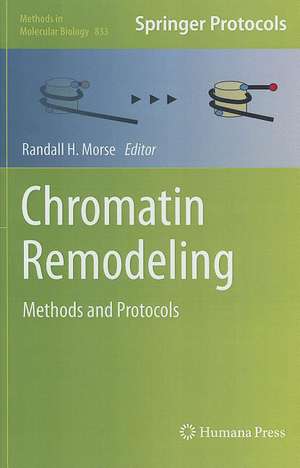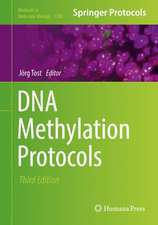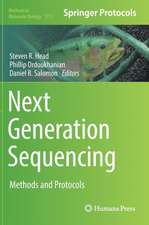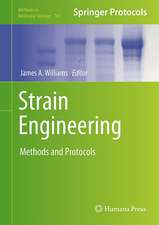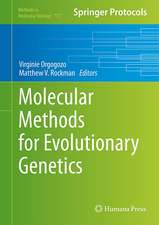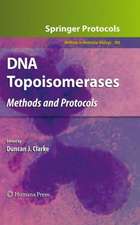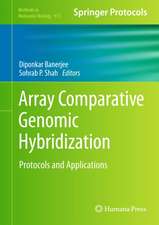Chromatin Remodeling: Methods and Protocols: Methods in Molecular Biology, cartea 833
Editat de Randall H. Morseen Limba Engleză Hardback – 21 dec 2011
Comprehensive and essential, Chromatin Remodeling: Methods and Protocols serves as a key source of clear techniques as well as a collection of chapters that can inspire future techniques in this vital field of study.
| Toate formatele și edițiile | Preț | Express |
|---|---|---|
| Paperback (1) | 1040.48 lei 6-8 săpt. | |
| Humana Press Inc. – 23 aug 2016 | 1040.48 lei 6-8 săpt. | |
| Hardback (1) | 739.13 lei 6-8 săpt. | |
| Humana Press Inc. – 21 dec 2011 | 739.13 lei 6-8 săpt. |
Din seria Methods in Molecular Biology
- 9%
 Preț: 791.63 lei
Preț: 791.63 lei - 23%
 Preț: 598.58 lei
Preț: 598.58 lei - 20%
 Preț: 882.98 lei
Preț: 882.98 lei -
 Preț: 252.05 lei
Preț: 252.05 lei - 5%
 Preț: 802.70 lei
Preț: 802.70 lei - 5%
 Preț: 729.61 lei
Preț: 729.61 lei - 5%
 Preț: 731.43 lei
Preț: 731.43 lei - 5%
 Preț: 741.30 lei
Preț: 741.30 lei - 5%
 Preț: 747.16 lei
Preț: 747.16 lei - 15%
 Preț: 663.45 lei
Preț: 663.45 lei - 18%
 Preț: 1025.34 lei
Preț: 1025.34 lei - 5%
 Preț: 734.57 lei
Preț: 734.57 lei - 18%
 Preț: 914.20 lei
Preț: 914.20 lei - 15%
 Preț: 664.61 lei
Preț: 664.61 lei - 15%
 Preț: 654.12 lei
Preț: 654.12 lei - 18%
 Preț: 1414.74 lei
Preț: 1414.74 lei - 5%
 Preț: 742.60 lei
Preț: 742.60 lei - 20%
 Preț: 821.65 lei
Preț: 821.65 lei - 18%
 Preț: 972.30 lei
Preț: 972.30 lei - 15%
 Preț: 660.49 lei
Preț: 660.49 lei - 5%
 Preț: 738.41 lei
Preț: 738.41 lei - 18%
 Preț: 984.92 lei
Preț: 984.92 lei - 5%
 Preț: 733.29 lei
Preț: 733.29 lei -
 Preț: 392.60 lei
Preț: 392.60 lei - 5%
 Preț: 746.26 lei
Preț: 746.26 lei - 18%
 Preț: 962.66 lei
Preț: 962.66 lei - 23%
 Preț: 860.22 lei
Preț: 860.22 lei - 15%
 Preț: 652.64 lei
Preț: 652.64 lei - 5%
 Preț: 1055.50 lei
Preț: 1055.50 lei - 23%
 Preț: 883.87 lei
Preț: 883.87 lei - 19%
 Preț: 491.89 lei
Preț: 491.89 lei - 5%
 Preț: 1038.86 lei
Preț: 1038.86 lei - 5%
 Preț: 524.16 lei
Preț: 524.16 lei - 18%
 Preț: 2122.34 lei
Preț: 2122.34 lei - 5%
 Preț: 1299.23 lei
Preț: 1299.23 lei - 5%
 Preț: 1339.12 lei
Preț: 1339.12 lei - 18%
 Preț: 1390.26 lei
Preț: 1390.26 lei - 18%
 Preț: 1395.63 lei
Preț: 1395.63 lei - 18%
 Preț: 1129.65 lei
Preț: 1129.65 lei - 18%
 Preț: 1408.26 lei
Preț: 1408.26 lei - 18%
 Preț: 1124.92 lei
Preț: 1124.92 lei - 18%
 Preț: 966.27 lei
Preț: 966.27 lei - 5%
 Preț: 1299.99 lei
Preț: 1299.99 lei - 5%
 Preț: 1108.51 lei
Preț: 1108.51 lei - 5%
 Preț: 983.76 lei
Preț: 983.76 lei - 5%
 Preț: 728.16 lei
Preț: 728.16 lei - 18%
 Preț: 1118.62 lei
Preț: 1118.62 lei - 18%
 Preț: 955.25 lei
Preț: 955.25 lei - 5%
 Preț: 1035.62 lei
Preț: 1035.62 lei - 18%
 Preț: 1400.35 lei
Preț: 1400.35 lei
Preț: 739.13 lei
Preț vechi: 778.03 lei
-5% Nou
Puncte Express: 1109
Preț estimativ în valută:
141.45€ • 147.13$ • 116.78£
141.45€ • 147.13$ • 116.78£
Carte tipărită la comandă
Livrare economică 14-28 aprilie
Preluare comenzi: 021 569.72.76
Specificații
ISBN-13: 9781617794766
ISBN-10: 1617794767
Pagini: 506
Ilustrații: XII, 456 p.
Dimensiuni: 178 x 254 x 33 mm
Greutate: 1 kg
Ediția:2012
Editura: Humana Press Inc.
Colecția Humana
Seria Methods in Molecular Biology
Locul publicării:Totowa, NJ, United States
ISBN-10: 1617794767
Pagini: 506
Ilustrații: XII, 456 p.
Dimensiuni: 178 x 254 x 33 mm
Greutate: 1 kg
Ediția:2012
Editura: Humana Press Inc.
Colecția Humana
Seria Methods in Molecular Biology
Locul publicării:Totowa, NJ, United States
Public țintă
Professional/practitionerCuprins
Strain Construction and Screening Methods for a Yeast Histone H3/H4 Mutant Library.- Measuring Dynamic Changes in Histone Modifications and Nucleosome Density during Activated Transcription in Budding Yeast.- Monitoring the Effects of Chromatin Remodelers on Long-Range Interactions In Vivo.- Measuring Nucleosome Occupancy In Vivo by Micrococcal Nuclease.- Analysis of Nucleosome Positioning Using a Nucleosome-Scanning Assay (NuSA).- Assaying Chromatin Structure and Remodeling by Restriction Enzyme Accessibility.- Generation of DNA Circles in Yeast by Inducible Site-Specific Recombination.- An Efficient Purification System for Native Minichromosome from S. cerevisiae.- Simultaneous, Single-Molecule Detection of Endogenous C-5 DNA Methylation and Chromatin Accessibility Using MAPit.- Analysis of Stable and Transient Protein-Protein Interactions.- Monitoring Dynamic Binding of Chromatin Proteins In Vivo by Fluorescence Recovery after Photobleaching (FRAP).- Monitoring Dynamic Binding of Chromatin Proteins In Vivo by Fluorescence Correlation Spectroscopy (FCS) and Temporal Image Correlation Spectroscopy (TICS).- Analysis of Chromatin Structure in Plant Cells.- Analysis of Histones and Histone Variants in Plants.- Reconstitution of Modified Chromatin Templates for In Vitro Functional Assays.- A Defined In Vitro System to Study ATP-Dependent Remodeling of Short Chromatin Fibers.- In Vitro Reconstitution of In Vivo-Like Nucleosome Positioning on Yeast DNA.- Activator-Dependent Acetylation of Chromatin Model Systems.- Mapping Assembly-Favored and Remodeled Nucleosome Positions on Polynucleosomal Templates.- Analysis of Changes in Nucleosome Conformation Using Fluorescence Resonance Energy Transfer (FRET).- Preparation of Nucleosomes Containing a Specific H2A-H2A Crosslink Forming a DNA-Constraining Loop Structure.- Sulfyhydryl Reactive Site-Directed Crosslinking as a Method for Probing the Tetrameric Structure of Histones H3 and H4.- Genomic Approaches for Determining Nucleosome Occupancy in Yeast.- Genome-Wide Approaches to Determining Nucleosome Occupancy in Metazoans Using MNase-Seq.- Salt Fractionation of Nucleosomes for Genome-Wide Profiling.- Quantitative Analysis of Genome-Wide Chromatin Remodeling.- Computational Analysis of Nucleosome Positioning.
Recenzii
From the reviews:
“This is an outstanding and timely collection of methods concerning how one can investigate chromatin remodelling. … There are detailed laboratory procedures and notes attached to all chapters, and this enable readers to use the volume as a laboratory manual. … The editor, Randall Morse, has to be congratulated on producing such an excellent book; a book that I recommend most highly to researchers in this arena.” (Raymond Waters, Human Genetics, Vol. 131, 2012)
“This is an outstanding and timely collection of methods concerning how one can investigate chromatin remodelling. … There are detailed laboratory procedures and notes attached to all chapters, and this enable readers to use the volume as a laboratory manual. … The editor, Randall Morse, has to be congratulated on producing such an excellent book; a book that I recommend most highly to researchers in this arena.” (Raymond Waters, Human Genetics, Vol. 131, 2012)
Textul de pe ultima copertă
Chromatin is of central importance to gene regulation in eukaryotes. Reflecting this singular role for chromatin, numerous approaches have evolved in the laboratory over the past three decades to study chromatin structure and its alterations. Methods of investigating chromatin remodeling, whether in changes in nucleosome structure or position with respect to the incorporated DNA or in histone modifications, have progressed rapidly over the recent years. In Chromatin Remodeling: Methods and Protocols, expert researchers contribute chapters which include methods for investigating chromatin remodeling in vitro and in vivo, in yeast, plants, and mammalian cells, and at local and global levels. Both gene-specific and genome-wide approaches are covered, and in recognition of the increasing prevalence of the latter type of study, the final two chapters focus on bioinformatic/computational approaches to analyzing genome-wide data on chromatin structure. Written in the highly successful Methods in Molecular Biology™ series format, the chapters include introductions to their respective topics, lists of the necessary materials and reagents, step-by-step, readily reproducible laboratory protocols, and tips on troubleshooting and avoiding known pitfalls.
Comprehensive and essential, Chromatin Remodeling: Methods and Protocols serves as a key source of clear techniques as well as a collection of chapters that can inspire future techniques in this vital field of study.
Comprehensive and essential, Chromatin Remodeling: Methods and Protocols serves as a key source of clear techniques as well as a collection of chapters that can inspire future techniques in this vital field of study.
Caracteristici
Features a wide range of methods, including in vitro, in vivo, visual, molecular, genomic, and computational Authored by recognized leaders in the field of chromatin biology Includes expert tips and implementation advice in order to ensure successful results Includes supplementary material: sn.pub/extras
